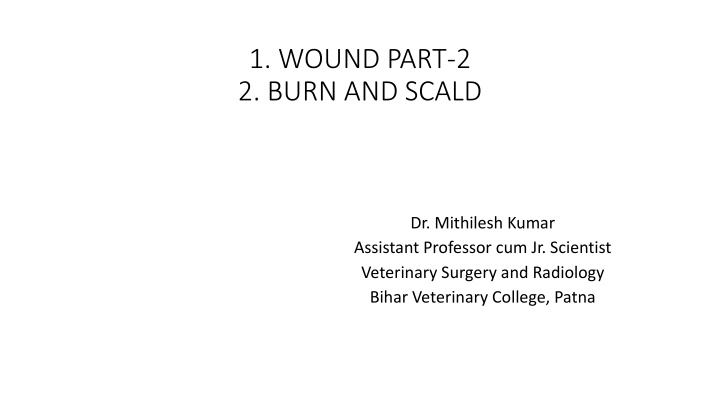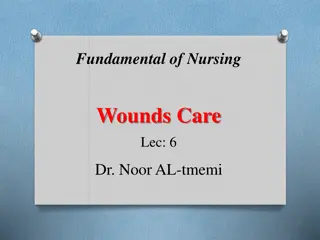Factors Affecting Delayed Wound Healing and Remedies
Understanding the factors that can delay wound healing is crucial for effective treatment. Bacterial infection, foreign bodies, devitalized tissues, desiccation, and inadequate blood supply are common culprits. Additionally, issues like hematoma, improper tissue apposition, and lack of immobilization can hinder the healing process. Remedies include addressing nutritional deficiencies, providing adequate wound care, and promoting proper tissue healing conditions.
Download Presentation

Please find below an Image/Link to download the presentation.
The content on the website is provided AS IS for your information and personal use only. It may not be sold, licensed, or shared on other websites without obtaining consent from the author.If you encounter any issues during the download, it is possible that the publisher has removed the file from their server.
You are allowed to download the files provided on this website for personal or commercial use, subject to the condition that they are used lawfully. All files are the property of their respective owners.
The content on the website is provided AS IS for your information and personal use only. It may not be sold, licensed, or shared on other websites without obtaining consent from the author.
E N D
Presentation Transcript
1. WOUND PART-2 2. BURN AND SCALD Dr. Mithilesh Kumar Assistant Professor cum Jr. Scientist Veterinary Surgery and Radiology Bihar Veterinary College, Patna
4. Third intension of healing : (Healing by secondary sutures) Third intension of healing takes place when the granulating surfaces of an extenssive wound, which may otherwise heal only by second intension, are united by sutures so as to bring about quicker healing. 5. Healing under scab: This healing occurs in superficial wounds like abrasions. The exudate present in the wound dries up and forms a scab. Underneath this scab the healing process takes place and when it is complete the scab automatically separates and is cast off.
Factor affecting delayed wound healing 1.Bacterial infection 2.Foreign bodies in the wound- foreign bodies increases exudation and delays the reparative process. 3.De-vitalisation of tissues: Devitalized tissues provide good media for bacterial growth.
4. Desiccation of tissues: Due to prolong exposure to air causes devitalization and delays healing and shows poor reparative capacity. 5. Hematomas and serum collections: Provide good media for bacterial growth. 6. Improper apposition of tissues and dead space etc : If there is a wide gap between the edges , healing is delayed. 7. Inadequate blood supply
7.Presence of malignant neoplastic tissue. 8.Lack of immobilization : Frequent movement of the wounded area causes rupture of newly formed granulation tissue and thereby delays healing. 9.Chemical and mechanical trauma delays wound healing. 11. Old age : Wound healing progresses slowly in animals of advanced
12. Malnutrition : specially protein deficiency delays wound healing. 13. Vitamin C deficiency: necessary for formation of intercellular substance and maturation of pre-collagen of connective tissue. 14. Vitamin K-deficiency : It is Concerned with coagulation of blood. Deficiency of Vitamin K predisposes to bleeding and formation of hematoma.
15. Deficiency of other vitamin : Vitamin A, D, Thiamin, riboflavin, pantothenic acid, etc. also cause delayed healing of wound. 16. Dehydration, water-logging, oedema etc. : are the other factors that might delay the healing of wound.
Thermal injuries Burns and scald An injury caused by hot solids, flame are burn. An injury caused by hot liquids or steam are scald. The degree of injury depends on the temperature of the object and its duration of contact with the body.
A scald is likely to be more severe than a burn because hot liquid may penetrate deeper into tissue. Classification : Burns are divided into three types according to thickness of tissue involved. First degree burns : involving only epidermis. Second degree burns : thickness of skin is involved more or less completely. Third degree burns : in which deeper tissues like subcutaneous fat or muscles are involved .
Symtoms: Physical symtoms :- The appearance of burnt area depends on degree of burns. First degree burns : Diffuse swelling and sometimes vesicle formation. The vesicle subside within about a week. Second degree burn : formed by the exudation of plasma. The exudation may continue for 36 to 48 hours. The blisters are very painful. Third degree burn : The complete thickness of skin plus subcutaneos fat or muscles or deeper tissue are involved. The dead of skin appears brownish black and leathery.
Surrounding area of burn shows oedema and hyperaemia. During healing dead portions slough off. Sloughing is slow process. The sloughed tissues are replaced by scar tissue which appears thin, shining and hairless, if hair roots are damaged.
Systemic reactions: There is intense pain and thirst. A varying degree of toxaemia is present. Shock develops if lesions are extensive and severe. Septicaemia may develop due to secondary bacterial infection.
Prognosis: Depends on extends of injury. Shock develops if more than 4% of the skin surface is affected by burn. Prognosis is unfavourable if more than 50% of the skin surface is involved. Treatment: 1st treat the dehydration and shock if present. Local treatment consists of applying emollients. Blister may be ruptured to drain the exudate.
If the skin surface is eroded, the exposed areas are protected by astringent, antiseptic and anodyne preparation. Local analgesics may be incorporated in these ointments to control pain. Antibiotic ointments and antibiotics systemically used infections.























